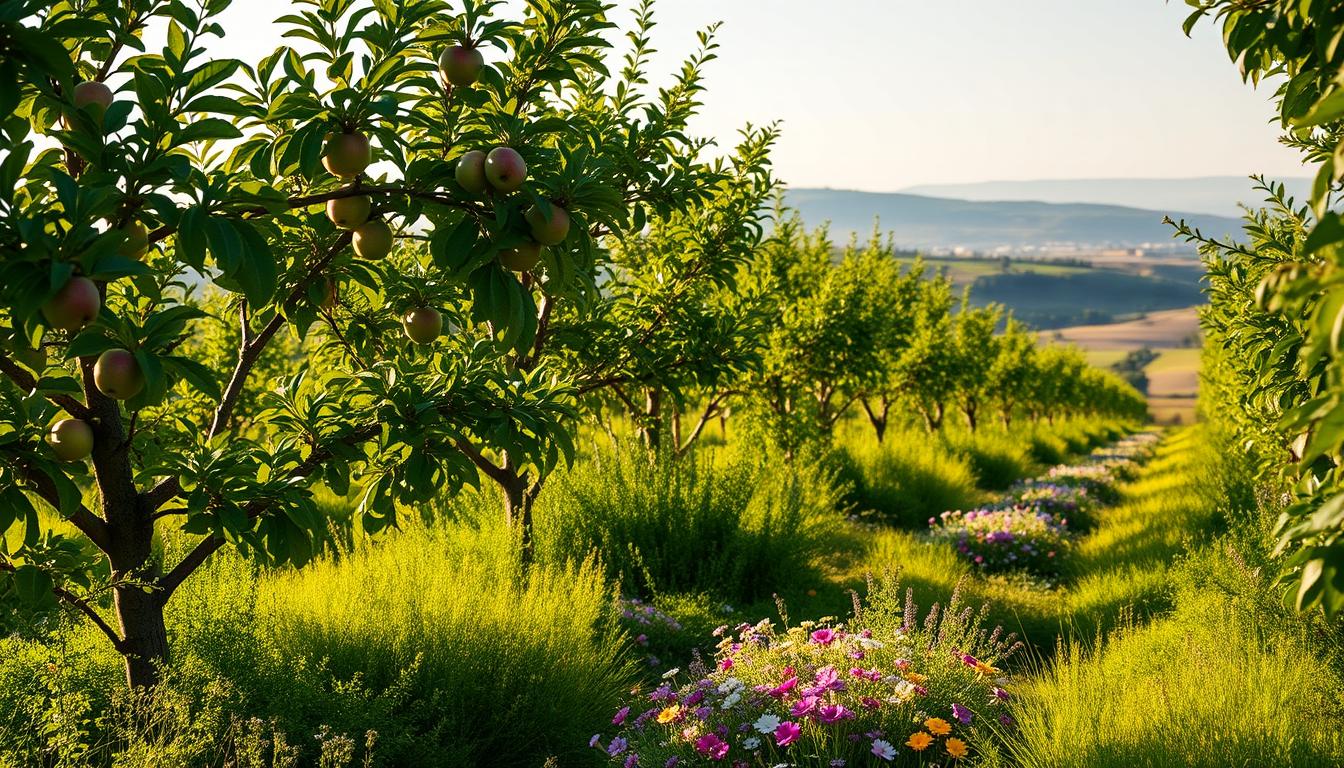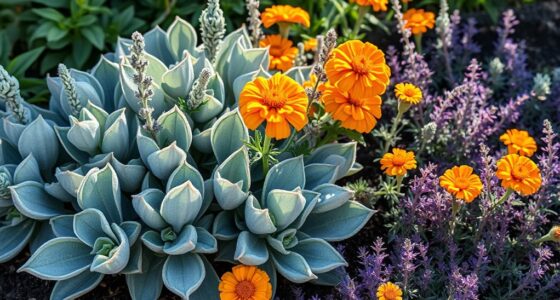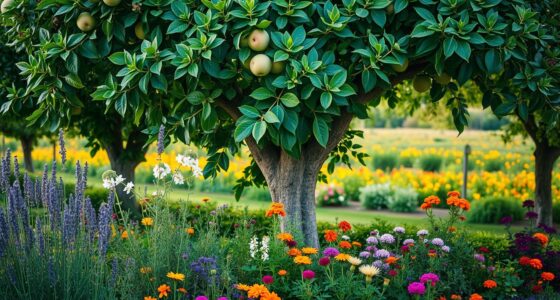There’s something magical about the sight of apple trees heavy with fruit, their boughs bending under the weight of nature’s bounty. As you wander through your orchard, you may find yourself dreaming of those crisp fall days when your harvest is ripe. But achieving that dream takes more than just planting apple trees; it requires a deeper understanding of companion planting for apple trees. By pairing your trees with the right plants, you can create a harmonious ecosystem that nurtures not only your apples but the entire orchard. Imagine walking among your trees knowing you’ve set the stage for improved pest control, enriched soil, and a flourishing environment. It’s not just about what you harvest; it’s about cultivating a thriving world around your fruit trees that benefits everything you grow.
Key Takeaways
- Companion planting for apple trees enhances growth and productivity.
- Creating a self-sustaining ecosystem leads to natural pest control.
- Healthy soil contributes to a bountiful harvest.
- Optimizing your orchard goes beyond the trees themselves.
- Strategically placing compatible plants can improve overall yield.
What is Companion Planting?
Companion planting refers to a gardening method where different plant species grow together to provide mutual benefits. This technique not only enhances the health of your garden but can also lead to stronger apple trees. By choosing the right plants, you create a thriving ecosystem around your apple tree, which can help repel pests, attract helpful insects, and improve soil quality. For anyone following the companion planting guide for apple trees, understanding these interactions is essential for achieving the best results.
Understanding the Basics
The core principle of companion planting revolves around selecting plants that can support each other. Some plants deter harmful insects, while others attract pollinators and beneficial insect species. When forming your apple tree guild planting, consider planting herbs like basil or marigolds, which have properties that can protect against pests. Additionally, certain plants can enhance soil health by fixing nitrogen and helping with nutrient absorption, creating a better growing environment for your apple trees.
Historical Significance
Historically, companion planting has deep roots in traditional agricultural practices from various cultures. Farmers observed that particular plants thrived when grown in proximity to others and used this knowledge to maximize their harvests. Ancient civilizations developed planting guilds, which are groups of plants that support each other, a concept that informs the modern practice of apple tree guild planting. This approach not only promotes biodiversity but encourages sustainable agricultural practices that can lead to healthier ecosystems.

| Plant Type | Benefits | Examples |
|---|---|---|
| Herbs | Repel pests and attract beneficial insects | Basil, Dill, Marigolds |
| Flowers | Attract pollinators and provide ground cover | Nasturtiums, Sunflowers |
| Vegetables | Enhance soil fertility and deter pests | Garlic, Onions |
Benefits of Companion Planting for Apple Trees
Companion planting provides numerous advantages for apple trees, making it a favored practice among organic apple tree companion planting enthusiasts. By incorporating certain plants into your orchard, you can enhance pest control measures, improve pollination rates, and boost soil health.
Improved Pest Control
Utilizing specific companion plants can significantly deter harmful pests from your apple trees. For instance, plants like garlic and chives are known for their ability to repel aphids, creating a healthier environment for your apple trees. This natural method of pest control minimizes the need for chemical pesticides, aligning perfectly with the principles of organic apple tree companion planting.
Enhanced Pollination
Companion plants such as flowering herbs and wildflowers play a crucial role in attracting beneficial pollinators. These pollinators, including bees and butterflies, contribute to increased fruit production. By ensuring a diverse range of plants in your orchard, you maximize the chances of successful pollination, reaping the benefits of improved yields from your apple trees.
Soil Health Improvement
The health of your soil influences the overall growth of your apple trees. Including nitrogen-fixing plants, such as clover, can enrich the soil with essential nutrients. Additionally, deep-rooting companion plants help stabilize soil structure and maintain moisture levels. By focusing on soil health through organic apple tree companion planting, you create a thriving ecosystem that supports your apple trees.
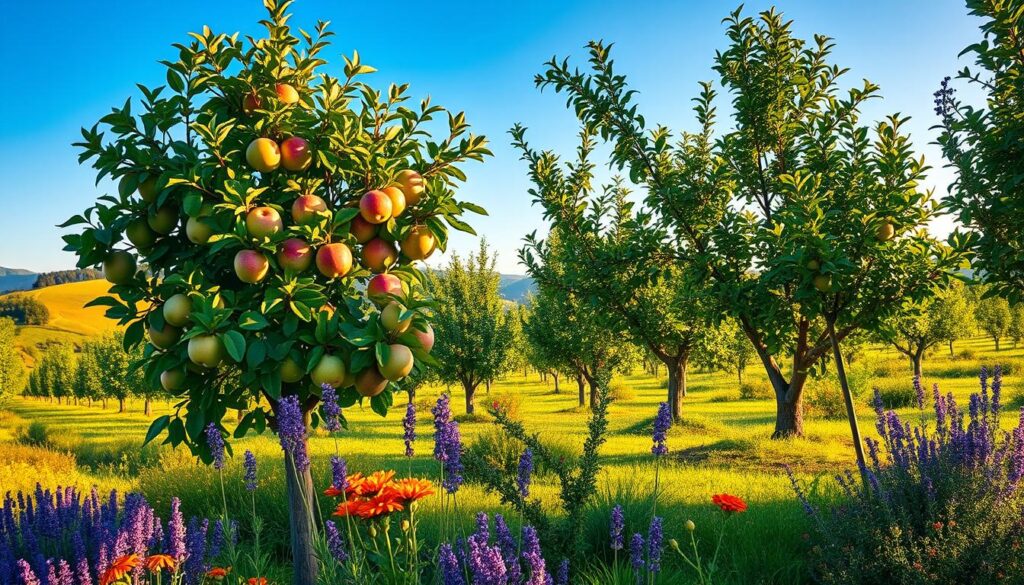
Best Companion Plants for Apple Trees
Choosing the right plants to accompany your apple trees can enhance their growth and overall productivity. Incorporating certain herbs, flowers, and vegetables not only supports the health of your trees but also promotes a balanced ecosystem in your garden. Here are some of the best companion plants for apple trees that you should consider.
Herbs that Help Apple Trees Thrive
Herbs can play a significant role in supporting apple trees. For instance, comfrey is known for its ability to accumulate nutrients, making it an excellent companion. Mint, with its vigorous growth, can effectively suppress weeds, ensuring your apple trees have access to essential resources without competition.
Flowers that Attract Beneficial Insects
Flowers such as nasturtiums are not only beautiful additions to your garden but also serve important functions. They attract pollinators like bees, which are essential for apple tree productivity. Additionally, nasturtiums can act as trap crops, drawing harmful pests away from your apple trees, providing a natural form of pest control.
Vegetable Companions to Consider
Vegetables can be excellent companions for your apple trees as well. Beans, for example, have a unique ability to fix nitrogen in the soil, which is beneficial for your apple trees. They grow quickly and efficiently, using space that would otherwise remain unutilized, further contributing to a healthy garden ecosystem.

Plants to Avoid When Growing Apple Trees
When you consider companion planting for apple trees, it’s vital to recognize that some plants can adversely affect their growth. Certain species may attract pests or compete for nutrients, leading to stress in your apple trees. Understanding these relationships helps you create a healthier orchard environment.
Common Pests and Their Host Plants
Pests such as aphids and borers can harm your apple trees. These pests often thrive on specific host plants. By recognizing these hosts, you can avoid planting them near your apple trees, reducing infestations. Here’s a brief overview of common pests and their preferred plants:
| Pest | Host Plants |
|---|---|
| Aphids | Mustard, Collards, Lettuce |
| Apple Borers | Plums, Cherries |
| Spider Mites | Cucumbers, Beans |
| Scale Insects | Peaches, Pears |
Incompatible Plant Species
Some plants can hinder the growth of your apple trees due to their release of harmful chemicals or nutritional competition. For example, sunflowers and black walnut trees can produce allelopathic chemicals, impairing apple tree health. Additionally, it’s wise to limit the planting of heavy feeders like corn and potatoes nearby.
By avoiding these pests and incompatible plants, you enhance the success of your companion planting for apple trees. Create a harmonious ecosystem that allows your apple trees to thrive and produce abundant fruit.

How to Plan Your Orchard Layout
Creating an effective orchard layout for apple tree guild planting enhances both plant health and productivity. Key considerations include spacing for companion plants and designing the area to maximize sunlight and airflow. Proper arrangement contributes significantly to the overall success of your apple trees and the plants that grow alongside them.
Spacing for Companion Plants
When planning your orchard, spacing is critical for optimizing the growth of all plants involved. Maintain approximately 3-4 feet between taller companion plants and the apple tree’s trunk. This distance minimizes root competition while allowing ample room for nutrients and water absorption. Ground covers should ideally be set 18-24 inches away from apple trees, promoting healthy growth while preventing potential over-shading.
Designing for Sunlight and Airflow
Consider sun exposure carefully when arranging your plants. Avoid crowded layouts that could lead to excessive shading and humid conditions, which are conducive to disease. Instead, aim for a balanced design that allows sunlight to reach all areas of your orchard. Utilize a companion planting chart for apple trees to visualize the optimal positioning of various plants, ensuring that all receive sufficient light and airflow for healthy growth.
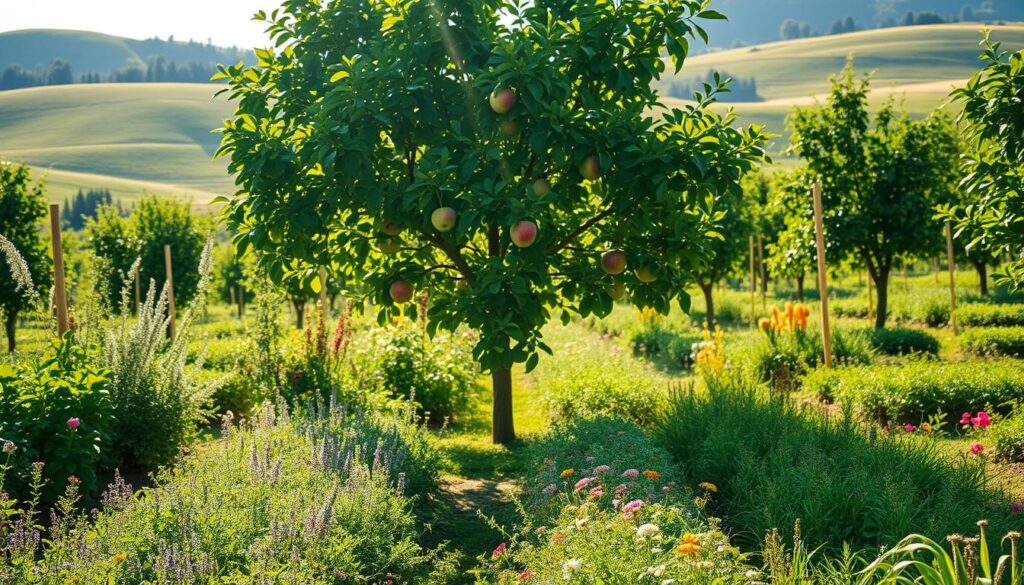
Seasonal Considerations in Companion Planting
When engaging in apple tree companion planting, seasonal timing proves essential for achieving optimum results. Understanding the specific needs of your plants in spring and summer will enhance productivity and promote a healthier orchard. Here’s how to make the most of your apple trees during these vital seasons.
Spring Planting Strategies
Spring marks an opportune time to introduce nitrogen-fixing crops like beans near your apple trees. These plants will enrich the soil, improving nutrient availability for your apple trees in the long run. Consider incorporating summer-blooming flowers during this period, as they will bloom shortly after planting, attracting beneficial insects that assist with pollination.
Summer Care Tips
Summer brings its set of demands. It’s crucial to monitor soil moisture levels, particularly for companion plants, as they can affect your apple trees’ water intake. Mulching around the base of apple trees helps retain soil moisture while preventing competition for water among companion plants. Observing pest activity in summer allows for timely intervention, ensuring the overall health of your garden.
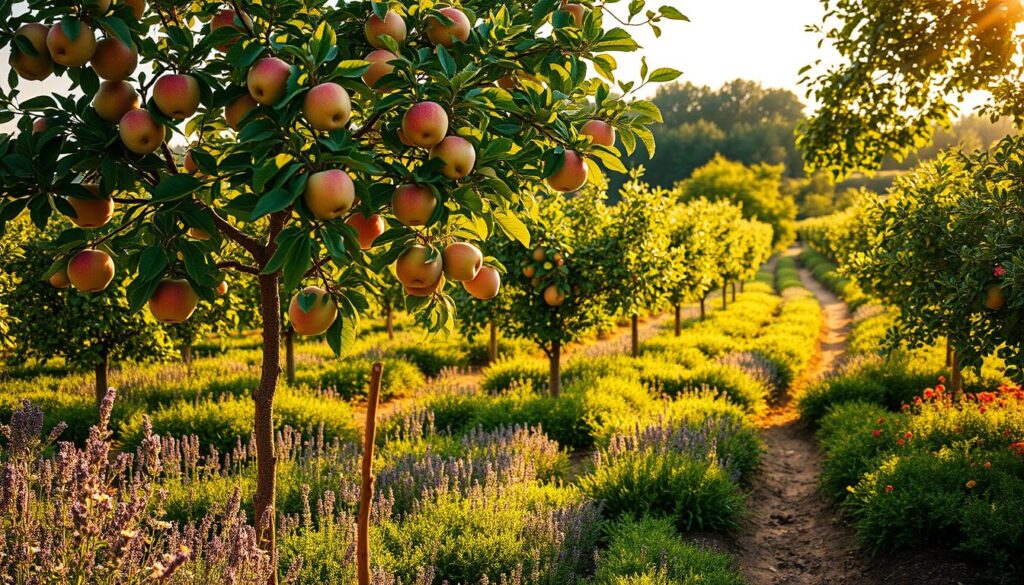
| Season | Action Items | Benefits |
|---|---|---|
| Spring |
|
|
| Summer |
|
|
Pest Management with Companion Plants
Effective pest management is crucial for maintaining a healthy apple orchard. Utilizing efficient techniques from the realm of apple tree companion planting tips can elevate your pest control effectiveness. Understanding which plants attract beneficial creatures and repel unwanted visitors can significantly enhance your gardening experience.
Natural Predators to Attract
Integrating specific plants into your orchard can attract natural predators, which serve as a biological control method. For instance, planting flowers like dill and fennel invites ladybugs and lacewings, both known for their voracious appetite for aphids and other harmful insects. These predators can establish a balance in your ecosystem, reducing the need for chemical pesticides.
Repelling Common Apple Tree Pests
Certain companion plants emit strong fragrances that deter common pests such as aphids, spider mites, and codling moths. Marigolds, for example, are widely recognized for their pest-repelling properties. Moreover, incorporating strong-scented herbs like mint can create an additional barrier against pests. Applying these companion planting methods can simplify your pest management strategy and support the overall vigor of your apple trees.
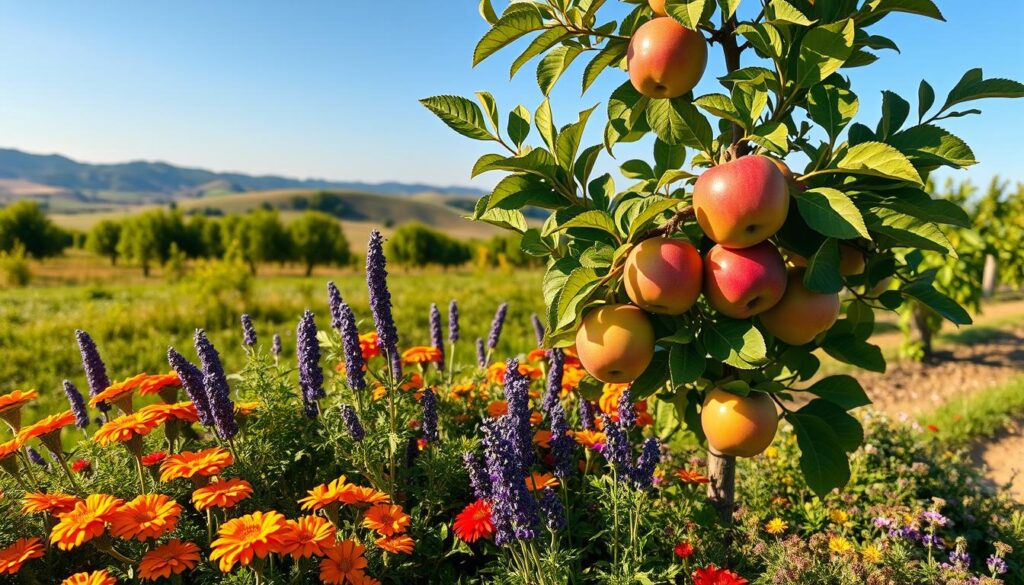
Companion Planting Techniques for Apple Trees
Utilizing effective companion planting techniques for apple trees can greatly enhance your orchard’s productivity and health. Two primary methods to consider are interplanting and companion blocks. Each technique offers unique benefits that can create a diverse ecosystem and support the well-being of your apple trees.
Interplanting vs. Companion Blocks
Interplanting involves planting different crops among your apple trees, creating a mixed planting approach. This technique fosters a biodiverse environment that can lead to improved pollination and natural pest control. By placing plants like marigolds or nasturtiums near your apple trees, you encourage beneficial insects that help mitigate pests.
On the other hand, companion blocks group together several compatible plants in designated areas. This method promotes growth and resilience through strategic plant relationships. For instance, grouping herbs alongside your apple trees can enhance soil health and deter harmful pests. Each approach has its merits, and selecting the right one depends on your specific orchard needs.
Using Ground Cover Plants
Ground cover plants serve a dual purpose in companion planting techniques for apple trees. Plants like creeping thyme or clover can suppress weeds, minimizing competition for resources. These ground covers also help retain soil moisture and maintain temperature, which can be crucial for apple tree growth. Furthermore, a well-chosen ground cover can provide a habitat for beneficial insects, ensuring a balanced ecosystem within your orchard.

| Technique | Benefits | Best Plants to Use |
|---|---|---|
| Interplanting | Diverse ecosystem, improved pollination | Marigolds, Nasturtiums |
| Companion Blocks | Strategic growth, pest deterrence | Herbs, Companion vegetables |
| Ground Cover | Weed suppression, moisture retention | Creeping Thyme, Clover |
Soil Preparation and Maintenance
Proper soil preparation and maintenance stand at the forefront of successful apple tree guild planting. These practices ensure a robust ecosystem that enhances growth while improving soil health over time. Focusing on enriching your soil sets a strong foundation for your plants, creating a harmonious environment that supports both your apple trees and their companions.
Best Practices for Soil Health
To achieve optimal soil health improvement, consider incorporating the following best practices:
- Add organic matter, such as compost or well-rotted manure, which enhances soil structure and provides essential nutrients.
- Conduct a soil test to identify existing nutrient levels and pH, guiding you in making informed amendments.
- Practice crop rotation to maintain nutrient balance and reduce pest build-up, ensuring healthy growth for your apple trees and companion plants.
- Implement mulching to conserve moisture, moderate soil temperature, and suppress weed growth, enhancing the longevity of soil health.
Amendments for Companion Planting
Effective amendments play a crucial role in creating an optimal environment for apple tree guild planting. Incorporating specific amendments can significantly boost your soil’s fertility and structure:
- Bone meal provides phosphorus, essential for root development and flowering.
- Compost tea supplies beneficial microbes that contribute to nutrient uptake and overall soil vitality.
- Wood ash acts as a natural fertilizer, enriching potassium levels while helping to balance soil acidity.
- Green manure, such as clover or vetch, enriches soil nitrogen levels when tilled into the ground.

Watering Strategies for Companion Gardens
Efficient watering strategies play a crucial role in the success of your companion garden surrounding apple trees. Implementing techniques that focus on both delivery and retention of water can maximize the growth potential of your plants. Understanding the companion planting benefits for apple trees can enhance your watering approach, ensuring plants remain healthy during both wet and dry conditions.
Techniques for Efficient Watering
Utilizing methods such as drip irrigation system helps deliver water directly to the root zones of your apple trees and their companions. This practice minimizes evaporation and runoff, making every drop count. Regular monitoring ensures your garden receives adequate moisture without overwatering.
Drought Resistance through Companion Planting
Incorporating drought-resistant species in your companion planting scheme can significantly improve moisture retention in the soil. Plants like lavender or rosemary can be paired with your apple trees, acting as natural buffers against dry spells. These companions not only thrive on minimal water but also create a microclimate that benefits apple trees.

| Watering Technique | Benefits | Ideal Conditions |
|---|---|---|
| Drip Irrigation | Reduces water waste, delivers moisture directly | Hot, dry climates |
| Soaker Hoses | Even moisture distribution, minimizes leaf wetness | All types of gardens |
| Rainwater Harvesting | Conserves resources, eco-friendly | Areas with seasonal rain |
| Mulching | Reduces evaporation, suppresses weeds | Any garden type |
Adopting these watering techniques along with understanding the companion planting benefits for apple trees creates a thriving, sustainable garden. Your apple trees, together with their companions, will flourish in a well-maintained watering environment, ensuring a bountiful harvest every season.
Fertilization Tips for Healthy Growth
Proper fertilization plays a crucial role in the health of both your apple trees and their companion plants. In organic apple tree companion planting, selecting the right fertilizers ensures that every plant receives the nutrients it requires for optimal growth. Organic fertilizers, such as fish emulsion and compost, provide nutrients without harmful chemicals, creating a healthier environment in your orchard.
Organic Fertilizers for Apple Trees
When it comes to nourishing your apple trees, organic fertilizers act as a valuable tool. Fish emulsion delivers high nitrogen levels, supporting vigorous growth, while compost enriches the soil microbiome. Regularly applying these organic options can enhance root development and overall tree health.
Nutrient Needs of Companion Plants
Understanding the nutrient needs of your companion plants is crucial in maintaining a balanced ecosystem. For instance, legumes such as clover and beans play a significant role in fixing nitrogen in the soil, benefiting nearby apple trees. Adapting your fertilization methods to meet the specific requirements of these plants ensures that your organic apple tree companion planting thrives, promoting a harmonious growth cycle throughout your orchard.

DIY Companion Planting Guides
Creating your own companion planting guide for apple trees can be both an enjoyable and practical endeavor. By tailoring your approach, you can optimize the benefits specific to your garden setup. Start by understanding the growth habits of different plants and how they interact with apple trees. This knowledge will help you make informed decisions when sketching out your planting chart.
Creating Your Own Companion Planting Chart
Your companion planting chart can serve as a major asset in maximizing the health and yield of your apple trees. Consider including details such as plant sizes, growth rates, and any specific requirements for sunlight and water. A simple visual layout can help you see how everything fits together. Here’s a basic example to guide you:
| Companion Plant | Benefits | Ideal Spacing (ft) |
|---|---|---|
| Basil | Repels pests and enhances flavor | 1-2 |
| Nasturtium | Attracts beneficial insects | 2-3 |
| Garlic | Deters aphids and other pests | 1-2 |
| Radishes | Encourages healthy soil | 1-2 |
Using Companion Planting in Small Spaces
Even with limited space, a companion planting guide for apple trees can yield fantastic results. Utilizing containers for herbs that thrive alongside your trees helps maximize the available resources. Consider stacking pots or using vertical gardening techniques to efficiently use every inch of available area. This small-scale approach ensures you can still reap the rewards of companion planting without needing extensive land.

Recognizing Signs of Successful Companion Planting
Understanding the signs that indicate successful companion planting will enhance your apple orchards. Pay attention to the visual cues your plants provide. Healthy apple trees thrive when paired correctly with their plant companions. Observing these indicators will guide you in implementing effective apple tree companion planting tips.
Healthy Growth Indicators
Several aspects reveal the vitality of your apple trees and their companions. Look for:
- Vibrant Foliage: Leaves should appear lush and green.
- Abundant Fruit: A good yield indicates proper plant harmony.
- Minimal Pest Presence: Few pests suggest effective companion functions.
Pest Control Effectiveness
Evaluating how well your companion plants control pests is essential. Successful combinations will result in:
- Attracting Beneficial Insects: Pollinators and predators can help manage harmful pest populations.
- Repelling Unwanted Pests: Some plants naturally deter pests, reducing damage to your apple trees.

Regular observation of these signs will provide you with insights into your gardening techniques and help refine your approach over time. Embrace these apple tree companion planting tips to nurture a flourishing orchard.
Conclusion: Elevate Your Orchard with Companion Planting
As you reach the end of this guide, it’s clear that the practice of companion planting plays a pivotal role in helping you optimize your orchard. By incorporating beneficial plants alongside apple trees, you’re not only enhancing pest control but also improving overall soil health. Your orchard can thrive with the right mix of herbs, flowers, and vegetables, creating a harmonious environment conducive to both plant growth and agricultural productivity.
Recap of Key Points
Throughout the article, we’ve explored various strategies that highlight the significance of companion planting for apple trees. From selecting the best companion plants to planning your orchard layout, each aspect is essential for establishing a flourishing ecosystem. Taking note of compatibility, spacing, and seasonal variations informs your approach and maximizes the benefits of your companion plants.
Encouragement to Experiment
Now is the perfect time to experiment with different plant pairings tailored to your specific orchard conditions. Don’t hesitate to try out unique combinations that resonate with your growing environment. As you dive into companion planting for apple trees, you may uncover effective strategies that contribute to exceptionally productive yields, making your orchard a thriving, vibrant landscape.
